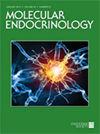缺氧增加mTOR抑制介导的IGFBP-1磷酸化。
Q Biochemistry, Genetics and Molecular Biology
引用次数: 22
摘要
在胎儿生长限制(FGR)中,胎儿生长受到营养和氧气供应减少的限制。胰岛素样生长因子I (IGF-I)是胎儿生长的关键调节因子,而IGF结合蛋白-1(IGFBP-1)是胎儿IGF-I生物利用度的主要调节因子。磷酸化增强了IGFBP-1对IGF-I的亲和力。缺氧诱导IGFBP-1过度磷酸化,显著降低igf -1的生物利用度。我们最近报道了胎儿肝脏IGFBP-1过度磷酸化与非人类FGR灵长类动物模型中雷帕霉素(mTOR)机制靶点的抑制有关。在这里,我们验证了IGFBP-1在缺氧反应中的过度磷酸化是由mTOR抑制介导的假设。在缺氧(1% O2)或基础(20% O2)条件下培养的HepG2细胞中,我们通过雷帕霉素或靶向raptor (mTOR复合物[mTORC]1)和/或rictor (mTORC2)的小干扰RNA (siRNA)抑制mTOR。相反,我们通过沉默内源性mTOR抑制剂(结节性硬化症复合体2/ dep结构域和mTOR相互作用蛋白)来激活mTORC1或mTORC1+mTORC2。免疫印迹分析表明,缺氧和抑制mTORC1和/或mTORC2均可诱导相似程度的IGFBP-1 Ser101/119/169磷酸化,并降低IGF-I受体的自磷酸化。mTORC1+mTORC2或mTORC1单独激活可阻止缺氧反应中IGFBP-1的过度磷酸化。多重反应监测-质谱分析显示,雷帕霉素和/或缺氧也增加了Ser98位点和Ser174位点的磷酸化。硅结构分析表明,Ser174靠近igf结合位点。总之,我们证明通过mTORC1或mTORC2途径的信号传导足以诱导IGFBP-1过度磷酸化以应对缺氧。本研究为缺氧条件下控制胎儿IGFBP-1磷酸化的细胞机制提供了新的认识,我们提出mTOR抑制在缺氧、igf -1生物利用度降低和FGR之间建立了机制联系。本文章由计算机程序翻译,如有差异,请以英文原文为准。
Hypoxia Increases IGFBP-1 Phosphorylation Mediated by mTOR Inhibition.
In fetal growth restriction (FGR), fetal growth is limited by reduced nutrient and oxygen supply. Insulin-like growth factor I (IGF-I) is a key regulator of fetal growth and IGF binding protein -1(IGFBP-1) is the principal regulator of fetal IGF-I bioavailability. Phosphorylation enhances IGFBP-1's affinity for IGF-I. Hypoxia induces IGFBP-1 hyperphosphorylation, markedly decreasing IGF-I bioavailability. We recently reported that fetal liver IGFBP-1 hyperphosphorylation is associated with inhibition of the mechanistic target of rapamycin (mTOR) in a nonhuman primate model of FGR. Here, we test the hypothesis that IGFBP-1 hyperphosphorylation in response to hypoxia is mediated by mTOR inhibition. We inhibited mTOR either by rapamycin or small interfering RNA (siRNA) targeting raptor (mTOR complex [mTORC]1) and/or rictor (mTORC2) in HepG2 cells cultured under hypoxia (1% O2) or basal (20% O2) conditions. Conversely, we activated mTORC1 or mTORC1+mTORC2 by silencing endogenous mTOR inhibitors (tuberous sclerosis complex 2/DEP-domain-containing and mTOR-interacting protein). Immunoblot analysis demonstrated that both hypoxia and inhibition of mTORC1 and/or mTORC2 induced similar degrees of IGFBP-1 phosphorylation at Ser101/119/169 and reduced IGF-I receptor autophosphorylation. Activation of mTORC1+mTORC2 or mTORC1 alone prevented IGFBP-1 hyperphosphorylation in response to hypoxia. Multiple reaction monitoring-mass spectrometry showed that rapamycin and/or hypoxia increased phosphorylation also at Ser98 and at a novel site Ser174. In silico structural analysis indicated that Ser174 was in close proximity to the IGF-binding site. Together, we demonstrate that signaling through the mTORC1 or mTORC2 pathway is sufficient to induce IGFBP-1 hyperphosphorylation in response to hypoxia. This study provides novel understanding of the cellular mechanism that controls fetal IGFBP-1 phosphorylation in hypoxia, and we propose that mTOR inhibition constitutes a mechanistic link between hypoxia, reduced IGF-I bioavailability and FGR.
求助全文
通过发布文献求助,成功后即可免费获取论文全文。
去求助
来源期刊

Molecular endocrinology
医学-内分泌学与代谢
CiteScore
3.49
自引率
0.00%
发文量
0
审稿时长
12 months
期刊介绍:
Molecular Endocrinology provides a forum for papers devoted to describing molecular mechanisms by which hormones and related compounds regulate function. It has quickly achieved a reputation as a high visibility journal with very rapid communication of cutting edge science: the average turnaround time is 28 days from manuscript receipt to first decision, and accepted manuscripts are published online within a week through Rapid Electronic Publication. In the 2008 Journal Citation Report, Molecular Endocrinology is ranked 16th out of 93 journals in the Endocrinology and Metabolism category, with an Impact Factor of 5.389.
 求助内容:
求助内容: 应助结果提醒方式:
应助结果提醒方式:


